Have you ever wondered why some plants thrive in courtyards while others struggle? How can you make a small space appear larger, and how do you make the most out of the limited space available? Courtyard gardening offers unique challenges and opportunities that require a nuanced understanding of growing conditions.
Courtyards, with their enclosed nature, create specific microclimates that can significantly impact plant growth for better and for worse. The key to a successful courtyard garden lies in understanding the conditions and choosing plants accordingly. This article will guide you through the essential considerations for specifying plants in courtyards, providing you with practical, real-world advice to maximise your garden’s potential.
After we’ve explored the growing conditions in a courtyard, we’ll also provide a lengthy list of plants that you can use for courtyard gardens.

In this photo, plants are screening the fence which can make us feel enclosed in a lush, intimate outdoor space. https://www.shutterstock.com/image-photo/beautiful-springtime-mediterranean-style-courtyard-garden-758315167
Understanding Courtyard Microclimates
What is a Microclimate?
A microclimate refers to the climatic conditions in a specific, localised area that differ from the surrounding region. In the context of courtyards, microclimates are particularly relevant due to the enclosed nature of these spaces. Unlike open gardens, courtyards often have unique temperature, humidity, and wind patterns that affect plant growth.
Key Microclimate Factors
- Temperature Variations: Courtyards can experience significant temperature fluctuations. They may retain more heat during the day and cool down rapidly at night, creating a unique environment for plants.
- Humidity Levels: Enclosed spaces like courtyards can have higher humidity levels. While this can be beneficial for some plants, it may also encourage the growth of mould and mildew.
- Wind Patterns: Courtyards typically have reduced wind exposure due to surrounding walls. However, this can lead to poor air circulation, making plants susceptible to fungal diseases. Ensuring proper ventilation is crucial.
Soil and Drainage Conditions
Soil Quality in Courtyards
Soil quality is a critical factor in courtyard gardening. Urban soils, particularly in new developments, are often poor because builders sometimes dump subsoil on top of topsoil, leading to compacted and nutrient-deficient layers. Identifying and amending soil issues is essential for plant health.
- Common Soil Issues: Compacted soil, low fertility, and poor structure are common problems. Incorporating organic matter, such as compost, can improve soil texture and nutrient content.
Ensuring Proper Drainage
Drainage can be a significant challenge in enclosed courtyards, where water may not flow away easily.
- Improving Drainage: Techniques include using raised beds or container gardening to enhance drainage. Installing proper drainage systems, such as French drains or permeable paving, can also help. Additionally, choosing plants that are tolerant of both flooding and drought conditions can mitigate drainage issues. Using raised beds can also improve drainage conditions.

Raised beds provide scale, layers and improved drainage. https://www.shutterstock.com/image-photo/small-courtyard-garden-seating-mixed-planting-544371379
Sunlight and Shade Management
Assessing Light Availability
Understanding light availability is crucial for selecting suitable plants. Monitor sunlight throughout the day and appreciate how it changes throughout the year. Full sun areas receive over 6 hours of light daily, partial sun areas get 4-6 hours, and heavy shade areas get less than 2 hours.
- Seasonal Changes: Some courtyard spaces can shift from full sun to heavy shade as the sun’s position changes seasonally. This dynamic can limit your plant palette but also offers an opportunity to choose adaptable species.
Maximising Light Use
Enhancing light availability can make a significant difference in plant growth.
- Strategies: Using reflective surfaces like mirrors or light-coloured walls can amplify available light. Removing unnecessary shading structures, such as dense pergolas, and employing strategic planting to position sun-loving plants in optimal spots can further maximise light use.
Watering and Irrigation
Courtyards require efficient watering practices due to their unique conditions.
- Efficient Watering Practices: Implementing systems like drip irrigation or soaker hoses ensures consistent moisture without waterlogging. Drought-tolerant plants can also be valuable in managing water use effectively.
Efficient Watering Practices
Special Considerations for Watering in Courtyards
Courtyards present unique watering challenges due to their enclosed nature and potential for poor drainage. Ensuring that plants receive adequate moisture without over-watering is crucial.
- Inconsistent Rainfall: Unlike open gardens, courtyards may not benefit equally from natural rainfall. This makes consistent, controlled watering essential.
- Watering Frequency: Monitor soil moisture regularly and adjust watering schedules based on plant needs and weather conditions.
Recommendations for Efficient Irrigation Systems
Efficient irrigation systems can help manage water use effectively, ensuring plants thrive without waste.
- Drip Irrigation: Delivers water directly to the base of plants, reducing evaporation and ensuring deep root watering. Ideal for a variety of plant types and well-suited to container gardening.
- Soaker Hoses: These hoses release water slowly along their length, providing even moisture distribution. They are particularly effective for raised beds and areas with multiple plants.
Drought-Tolerant Plants
Benefits of Choosing Drought-Tolerant Species
Drought-tolerant plants are well-suited to courtyards where water availability may fluctuate, offering several advantages:
- Low Maintenance: These plants require less frequent watering, making them ideal for busy gardeners or those looking to reduce water usage.
- Resilience: Drought-tolerant species can withstand periods of dry conditions, ensuring the garden remains lush even during water restrictions. They’re also better able to tolerate the faster evaporation typical of small garden beds nearby sources of reflective heat like pavers and concrete.
Aesthetic and Functional Design
Enhancing the Courtyard with Plants
Courtyards offer a unique opportunity to create visually appealing and functional garden spaces.
- Vertical Gardens and Green Walls: Use vertical space to maximise planting area. Green walls can add texture and colour, as well as improve air quality and insulation.
- Focal Points: Plants can be strategically placed to create focal points, drawing the eye and enhancing the aesthetic appeal. For instance, a small tree or a large planter can serve as a centrepiece.
- Foliage Impact: Fine foliage can make small spaces appear larger by adding depth without overwhelming the area. Conversely, large foliage can create a more intimate feel by filling space visually.
Multipurpose Plant Features
Select plants that offer both beauty and functionality to maximise the utility of your courtyard space. Here are some
- Ground Cover: Low-growing plants like creeping thyme or ground-cover roses can prevent soil erosion and add greenery.
- Erosion Control: Plants with strong root systems, such as ferns or sedges, can help stabilise soil in raised beds or sloped areas.
- Wet Feet and Drought Tolerance: Plants like daylilies or ornamental grasses can thrive in varying moisture conditions.
- Low Maintenance: Opt for hardy plants that require minimal care, such as ground-covers, strappy plants and slow-growing compact hedges.
- Biodiversity Resources: Include plants that attract pollinators or provide habitat for beneficial insects, like scaevola, callistemon and eremophila. Make sure there are lots of resources for early spring as the bulk of insect activity is warming up, as well as some resources for the whole year. Grevilleas and correas are excellent winter-flowering plants that help pollinators when resources are scarce, as well as helping in early spring.
- Screening: Use tall, narrow plants like columnar hedges and climbers to create privacy screens in tight spaces.
Choosing Suitable Plants
Characteristics of Ideal Courtyard Plants
Ideal courtyard plants should possess certain traits to thrive in the unique conditions of an enclosed garden.
- Tolerance to Conditions: Select plants that can handle shade, wet feet, or other specific conditions of your courtyard. If your space has a lot of concrete, metal, glass or rocks, there will be a lot of reflected heat and sunlight to take into account.
- Compact Growth: Choose plants that remain small or grow slowly to avoid overcrowding and maintenance challenges. Avoid plants that have a mature size larger than the space can accommodate.
- Aesthetics: Fine foliage can make spaces appear larger, while large foliage can provide a sense of enclosure. Choose varieties that have a dense growth habit, rather than a sparse habit, to fit more foliage and colour into the space.
Best Courtyard Plants
Low Horizon™ Westringia fruticosa ‘WES06’ PBR
Low Horizon™ Westringia is a dense, ultra-compact ground cover with minimal maintenance needs. It features much shorter internodes and a flat habit, making it the lowest maintenance ground cover within the Westringia range. Occasional pruning enhances its compact appearance. This plant is especially attractive when paired with Grey Box™ plants and Lomandra varieties. It features the small, needle-like foliage typical of the genus, which help make spaces appear larger.
Size
Low Horizon™ Westringia grows to a height of 30 cm and spreads up to 70 cm wide. For optimal coverage, it should be planted at a density of 2-3 plants per square metre or per linear metre.
Sunlight Requirements
This versatile ground covering shrub thrives in full sun to part shade conditions.
Soil Preferences
Low Horizon™ Westringia adapts well to sandy to well-drained clay soils. It is highly tolerant of a range of soil conditions, provided the soil is well-draining.
Care
Care for Low Horizon™ Westringia involves watering as needed for the first 8-13 weeks until the plant is well established, after which it’s tolerant to drought. It should be planted in a well-mulched garden, with chunky mulch being recommended. If necessary, a slow-release fertiliser can be applied in spring – a balanced NPK ratio is perfect and “native” fertilisers aren’t needed (they’re mainly for Proteaceae family members like grevilleas). Pruning can be done as required to maintain its desired shape and compactness.
Climate
Suitable for:
- New South Wales
- Victoria
- South Australia
- Western Australia
- Australian Capital Territory
- Tasmania
It has been tested for cold tolerance in Canberra and handles frost and cold well. It also performs well in Sydney’s and Brisbane’s humid climates.
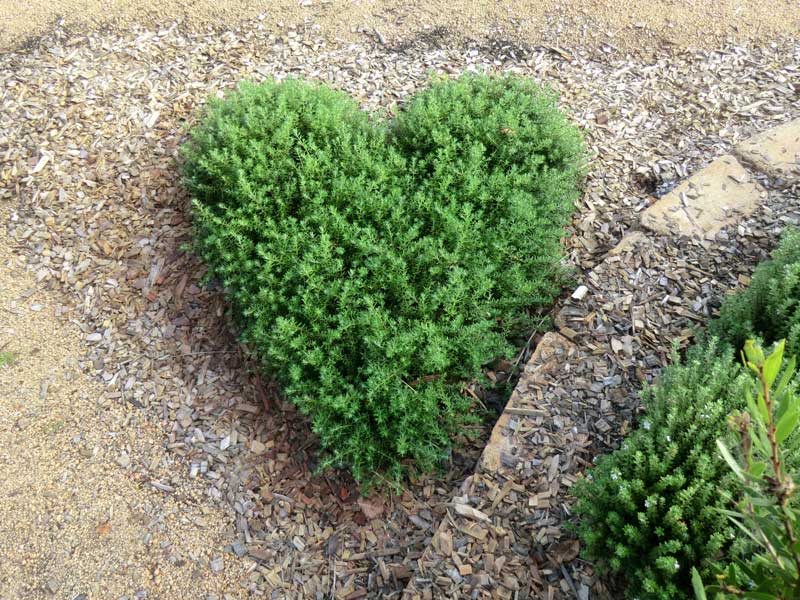
Grey Box™ Westringia fruticosa ‘WES04’ PBR
Grey Box™ Westringia is a drought and flood-tolerant native box hedge plant with dense foliage and neat, compact form. It’s particularly low-maintenance, requiring very little pruning to maintain its shape, or can be left to express its natural shape. This versatile plant is ideal for hedging and borders in small or large spaces, providing a tidy, uniform appearance.
Size
Grey Box™ Westringia typically grows to a height of 30-45 cm and a width of 30-45 cm. It is perfect for creating low hedges or as a compact ground cover.
Sunlight Requirements
This hardy plant thrives in full sun to part shade conditions.
Soil Preferences
Grey Box™ Westringia can tolerate most soils, including sandy and heavy clay soils. Use this plant for areas that have poor drainage.
Care
Care for Grey Box™ Westringia includes minimal maintenance due to its low water requirements once established. It should be watered regularly during the first 8-13 weeks after planting. Light pruning can be done to maintain its shape, though it generally retains a tidy form without much intervention. Use a slow-release fertiliser in spring if necessary.
Climate
Suitable for:
- New South Wales
- Victoria
- South Australia
- Western Australia
- Australian Capital Territory
- Tasmania
Grey Box™ Westringia has been tested for cold tolerance, handling frost and cold conditions well. It is also well-suited to Sydney’s humid climate and is being assessed for wet feet tolerance in Queensland.

https://www.ozbreed.com.au/plant-ranges/native-shrubs-groundcovers/grey-box-westringia-is-a-drought-tolerant-native-box-hedge-plant-native-shrubs-ground-covers/
Better John™ Callistemon viminalis ‘LJ1’ PBR
Better John™ Callistemon is a cultivar bred from Little John, known for its improved ease of growth, quicker establishment, and better foliage colour. It features blue-green toned mature foliage, with new growth exhibiting silver tones due to a soft hairy texture. It blooms from mid-spring to late spring with small red flowers. It’s tolerant of flooding, drought, frost, myrtle rust and Phytophthora.
Size
Better John™ Callistemon grows to a height of 60 cm to 1.2 m and spreads 60 to 90 cm wide. For planting density, use 3-5 plants per square metre or 1.5-2 plants per linear metre.
Sunlight Requirements
This plant thrives in full sun to part shade conditions.
Soil Preferences
Better John™ Callistemon suits sandy to heavy soils. It is tolerant of drought, wet and cold conditions.
Care
Care for Better John™ Callistemon involves watering as needed for the first 8-13 weeks until established. It should be planted in a well-mulched garden, with chunky mulch recommended. If necessary, apply a slow-release fertiliser in spring. Pruning every 3-4 years is suggested for a natural shape, or every 2 years for a tidy hedge.
Climate
Suitable for:
- Queensland
- New South Wales
- Australian Capital Territory
- Victoria
- Tasmania
- South Australia
- Western Australia
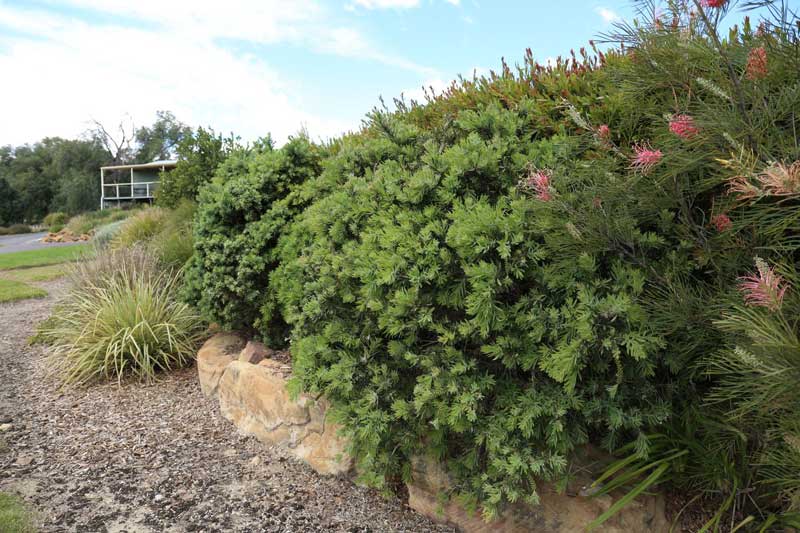
Green John™ Callistemon viminalis ‘LJ23’ PBR
Green John™ Callistemon is a dense native shrub featuring attractive light green new growth that contrasts well with its older dark green foliage and striking red flowers. It is faster growing and establishes more quickly than Little John, offering a vibrant addition to gardens with its seasonal blooms from September to November. It is also highly resistant to Myrtle Rust and Phytophora, as well as drought, frost and flooding.
Size
Green John™ Callistemon grows to a height of 60 cm to 1 metre and reaches a width of 60 cm. For optimal planting density, use 3-6 plants per square metre or 2-2.5 plants per linear metre.
Sunlight Requirements
This plant thrives in full sun to part shade conditions.
Soil Preferences
Green John™ Callistemon suits sandy to well-drained soils. It tolerates drought and cold, making it robust across different environments.
Care
Care for Green John™ Callistemon involves watering as required for the first 8-13 weeks until established. Plant it in a well-mulched garden, with chunky mulch being recommended. If necessary, apply a slow-release fertiliser in spring. Pruning can be done every 3-4 years for a natural shape or every 2 years for a tidy hedge.
Climate
Suitable for:
- Queensland
- New South Wales
- Australian Capital Territory
- Victoria
- Tasmania
- South Australia
- Western Australia

Slim™ Callistemon viminalis ‘CV01’ PBR
Slim™ Callistemon is a unique bottlebrush shrubby tree with a narrow growth habit, making it ideal for screening in tight planting areas. It is highly versatile, serving well as a screen, hedge, or feature plant in tight spaces. This variety has high resistance to Phytophthora and myrtle rust and tolerant to wet feet, drought and frost. It produces numerous flower buds in spring that bloom into classic red bottlebrush flowers throughout spring, summer, and autumn.
Size
Slim™ Callistemon reaches a height of 3 metres and a width of 1.3 metres. For optimal coverage, plant at a density of 1-3 plants per square metre or 1-1.5 plants per linear metre.
Sunlight Requirements
This plant thrives in full sun to part shade conditions.
Soil Preferences
Slim™ Callistemon suits most soil types and is particularly tolerant of drought, flooding and frost conditions.
Care
Care for Slim™ Callistemon includes watering for the first 8-13 weeks until established. It should be planted in a well-mulched garden, with chunky mulch recommended. If necessary, apply a slow-release fertiliser in spring. Pruning can be done 1-3 times a year after a flush of flowering to maintain a tidy hedge or desired shape, depending on your requirements.
Climate
Suitable for:
- Queensland
- New South Wales
- Australian Capital Territory
- Victoria
- Tasmania
- South Australia
- Western Australia
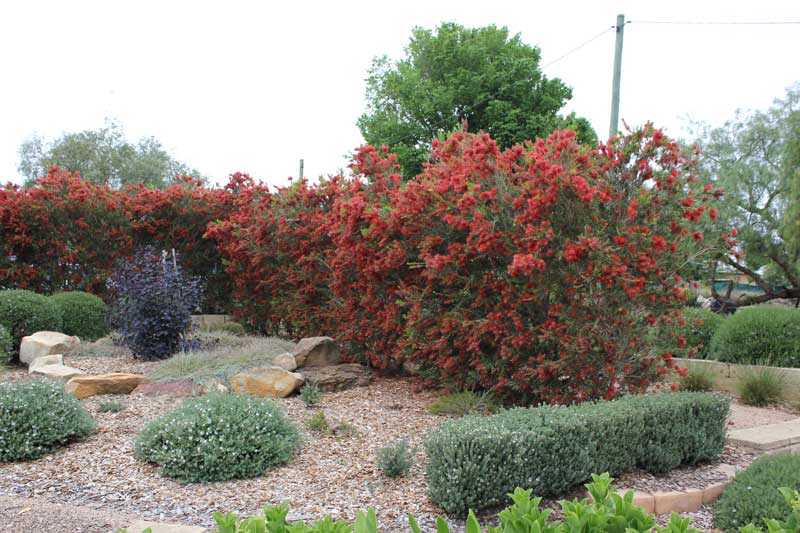
Crimson Villea™ Grevillea rosmarinifolia ‘H16’ PBR
Crimson Villea™ Grevillea is a tough, compact shrub with dense foliage and an abundance of crimson flowers that bloom in autumn, winter, and early spring. In fact, we believe it’s the best winter-flowering plant ever bred. Compared to Scarlet Sprite, it’s less fussy and performs well even under frost down to -5°C and moderate humidity.
Size
Crimson Villea™ Grevillea grows to a height of 80 cm and a width of 80 cm. For optimal coverage, plant at a density of 1-2 plants per square metre or 1-1.5 plants per linear metre.
Sunlight Requirements
This plant thrives in full sun to light shade.
Soil Preferences
Crimson Villea™ Grevillea suits well-drained soils and is tolerant of both frost and drought conditions.
Care
Care for Crimson Villea™ Grevillea includes watering as required for the first 8-13 weeks until established. It should be planted in a well-mulched garden, with chunky mulch recommended. An annual application of slow-release fertiliser is beneficial. Because it’s in the Proteaceae family, a native fertiliser is recommended in this case. Pruning every 2 years or annually will ensure the best performance.
Climate
Suitable for:
- New South Wales
- Australian Capital Territory
- Victoria
- Tasmania
- South Australia
- Western Australia
- Parts of South East Queensland
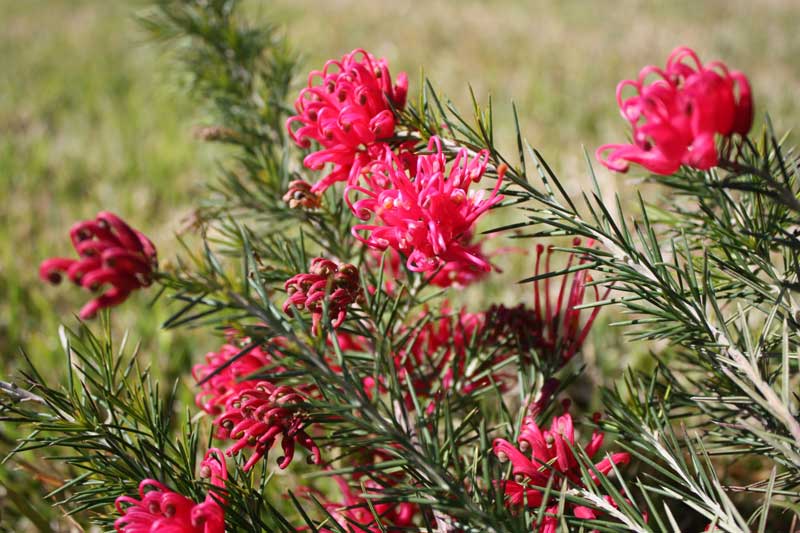
https://www.ozbreed.com.au/plant-ranges/native-shrubs-groundcovers/crimson-villea-grevillea/
Fire Bells™ Correa pulchella ‘COR11’ PBR Intended
Fire Bells™ Correa is a compact ground cover with vibrant orange/red flowers that bloom in winter and early spring. It requires minimal pruning to maintain its compact form, making it ideal for small gardens, courtyards, patios, and containers. This plant attracts birds and adds a splash of colour during the cooler months.
Size
Fire Bells™ Correa grows to a short height of 25 cm and spreads up to 80 cm wide, though it can be kept smaller with regular pruning. For optimal coverage, plant at a density of 2-5 plants per square metre or 2-3 plants per linear metre.
Sunlight Requirements
This plant thrives in full sun to light shade.
Soil Preferences
Fire Bells™ Correa prefers reasonably drained soils (particularly in Sydney with the humidity) but is adaptable to most soil types. It tolerates both drought and frost conditions once established.
Care
Care for Fire Bells™ Correa includes watering as required for the first 8-13 weeks until established. Plant it in a well-mulched garden, using chunky mulch for best results. Prune once a year to maintain a semi-compact habit or twice per year for a more manicured appearance. Fertilise with a slow-release native fertiliser to promote healthy growth.
Climate
Suitable for:
- Victoria
- Australian Capital Territory
- South Australia
- Western Australia
- Tasmania
- Southern New South Wales and Sydney (in well-draining soils)
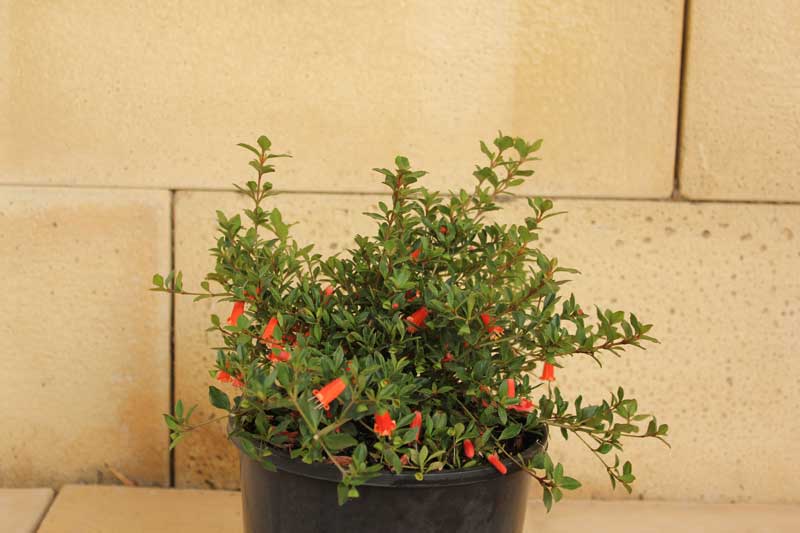
Straight and Narrow™ Syzygium australe ‘SAN01’ PBR Intended
Straight and Narrow™ Syzygium is a very slender, semi-compact, and dense columnar shrub or tree. It features tight, attractive leaves, accompanied by white flowers that develop into beautiful pink/red fruit. This plant has a natural psyllid resistance, which are the insects commonly referred to as “scale” that commonly make lilly pilly leaves bumpy.
Size
Straight and Narrow™ Syzygium typically grows to a height of 5-8 metres and a width of 1-1.5 metres. It can be pruned down to a height of 2 metres if desired. For optimal coverage, plant at a density of 1 plant per square metre or 1-1.5 plants per linear metre.
Sunlight Requirements
This plant thrives in full sun to shade, making it perfect along fencelines where the plants have limited access to light until they grow above the fence, when they have to contend with full sun.
Soil Preferences
Straight and Narrow™ Syzygium suits moist, well-drained soil types and tolerates both cold and dry conditions.
Care
Care for Straight and Narrow™ Syzygium includes watering as required for the first 8-13 weeks until established. Plant it in a well-mulched garden, with chunky mulch recommended. If necessary, apply a slow-release fertiliser in spring. Prune twice yearly for a very tidy hedge, or every 2-3 years if used as a wider screen plant.
Climate
Suitable for:
- Queensland
- New South Wales
- Victoria
- South Australia
- Western Australia
- Australian Capital Territory (if protected from frosts)

https://www.ozbreed.com.au/plant-ranges/native-shrubs-groundcovers/straight-and-narrow/
Aussie Flat Bush™ Rhagodia spinescens ‘SAB01’ PBR
Aussie Flat Bush™ Rhagodia is a low-growing, compact shrub featuring small blue foliage. It is well-suited for both inland and coastal situations across Australia. This plant makes an excellent low-growing hedge or mounding ground cover and performs best with annual pruning or more frequent trimming for a manicured look. Its blue foliage is striking in mass plantings as well as when used as a specimen plant.
Size
Aussie Flat Bush™ Rhagodia typically grows to a height of 30-50 cm and spreads up to 1 metre wide. For optimal coverage, plant at a density of 1-2 plants per square metre or 1-2 plants per linear metre.
Sunlight Requirements
This plant thrives in full sun to light shade, making it adaptable to various garden settings.
Soil Preferences
Aussie Flat Bush™ Rhagodia suits most soil types, including heavy soils. It is highly drought-tolerant and adapted to both low and higher rainfall areas.
Care
Care for Aussie Flat Bush™ Rhagodia includes watering as required for the first 8-13 weeks until established. Plant it in a well-mulched garden, with chunky mulch recommended. If necessary, apply a slow-release fertiliser in spring. Prune twice yearly in gardens for the best appearance, though it doesn’t require pruning for low-maintenance gardens.
Climate
Suitable for:
- New South Wales
- Australian Capital Territory
- Victoria
- Queensland (non-humid inland areas)
- South Australia
- Western Australia
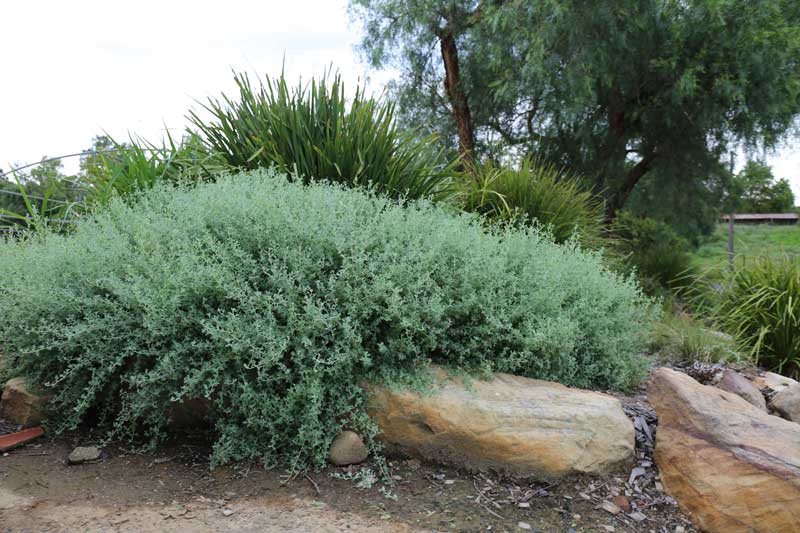
Yareena™ Myoporum parvifolium ‘PARV01’ PBR
Yareena™ Myoporum is a durable ground cover known for its crisp, clean small foliage and masses of white flowers. This longer-lived variety features thick, woody stems that hold their leaves much better than other varieties. The plant’s attractive foliage and flowers make it a great choice for various landscape applications.
Size
Yareena™ Myoporum grows to a height of 10 cm and spreads up to 1 metre wide. For optimal coverage, plant at a density of 1-2 plants per square metre.
Sunlight Requirements
This plant thrives in full sun to part shade conditions, making it versatile for different garden settings.
Soil Preferences
Yareena™ Myoporum suits a wide variety of soils, from sandy to heavy clay. It is highly tolerant of both frost and drought once established.
Care
Care for Yareena™ Myoporum includes watering as required for the first 8-13 weeks until established. Plant it in a well-mulched garden, with chunky mulch recommended. If needed, apply a slow-release fertiliser in spring. Prune once every two years to maintain a tidy appearance. You can prune it with a hedge trimmer back to a border, or you can selectively remove larger stems back to a fork to reduce the plant’s size.
Climate
Suitable for:
- Queensland
- New South Wales
- Australian Capital Territory
- Victoria
- Tasmania
- South Australia
- Western Australia

Blue Horizon™ Eremophila glabra prostrate ‘EREM1’ PBR
Blue Horizon™ Eremophila is a low-growing ground cover with tidy blue-grey foliage. It produces beautiful yellow flowers in winter that birds and insects love. The plant is characterised by shorter internodes, which provide a denser and tidier appearance compared to other varieties.
Size
Blue Horizon™ Eremophila grows to a height of 25 cm and spreads up to 1 metre wide, perfect as a ground cover in a small space. For optimal coverage, plant at a density of 1-2 plants per square metre or 1-2 plants per linear metre.
Sunlight Requirements
This plant thrives in full sun to light shade.
Soil Preferences
Blue Horizon™ Eremophila prefers free-draining soil but can handle heavier soils in drier climates. It is highly drought-tolerant once established.
Care
Care for Blue Horizon™ Eremophila includes watering as required for the first 8-13 weeks until established. Plant it in a well-mulched garden, with chunky mulch recommended. If necessary, apply a slow-release fertiliser in spring. For a more manicured look, prune to shape in autumn or spring every 2-3 years.
Climate
Suitable for:
- South Australia
- Western Australia
- Victoria
- Sydney and Southern New South Wales (requires free-draining soil in Sydney; testing still to occur for regions north of Sydney)

https://www.ozbreed.com.au/plant-ranges/native-shrubs-groundcovers/blue-horizon-eremophila/
Ozbreed Flat White™ Pandorea jasminoides ‘PJ01’ PBR
Ozbreed Flat White™ Pandorea is a dense and compact climber, notable for its masses of pure white flowers that appear in late spring and summer. This plant is perfect for narrow spaces, making it ideal for covering fences and trellises to create a screen in a courtyard.
Size
When pruned, Ozbreed Flat White™ Pandorea grows to a height of 2-3 metres and a width of 40-60 cm. If left unpruned, it can spread between 80 cm to 2 metres. For optimal coverage, plant at a density of 1-3 plants per linear metre. It grows more slowly and tightly than other varieties.
Sunlight Requirements
This plant thrives in full sun to part shade, making it versatile for various garden settings.
Soil Preferences
Ozbreed Flat White™ Pandorea suits most soil types, showing moderate frost tolerance and good drought tolerance once established.
Care
Care for Ozbreed Flat White™ Pandorea includes watering as required for the first 8-13 weeks until established. Plant it in a well-mulched garden, with chunky mulch recommended. Apply slow-release fertiliser in spring if needed. Prune a few months after planting, then twice per year to maintain its narrow, tight climbing form. Train stems horizontally along the base of the trellis to encourage better coverage, because lateral stems will naturally grow upwards from those horizontal stems.
Climate
Suitable for:
- South Queensland
- New South Wales
- Victoria
- Tasmania
- South Australia
- Western Australia

https://www.ozbreed.com.au/plant-ranges/native-shrubs-groundcovers/ozbreed-flat-white/
Evergreen Baby™ Lomandra labill ‘LM600’ PBR
Evergreen Baby™ Lomandra is a compact, fine-leaved, and evergreen plant. It is highly durable, capable of tolerating both wet feet and drought conditions. This plant produces numerous golden flowers in spring and is male sterile. It is about half the size of the popular Tanika® Lomandra, making it perfect for situations where a tough, smaller plant is needed.
Size
Evergreen Baby™ Lomandra typically grows to a height of 40-45 cm and spreads up to 45 cm wide. For optimal coverage, plant at a density of 4-8 plants per square metre or 2-4 plants per linear metre.
Sunlight Requirements
This plant thrives in full sun to part shade.
Soil Preferences
Evergreen Baby™ Lomandra performs well in a range of soil types, from sandy loam to heavy clay. It is tolerant of frost, drought, and periodic wet feet.
Care
Care for Evergreen Baby™ Lomandra includes watering as required for the first 8-13 weeks until established. Plant it in a well-mulched garden, with chunky mulch recommended. Ensure the crown or base of the plant is not below soil or mulch level. If necessary, apply a slow-release fertiliser in spring. Cut back to 15 cm above the ground every 3-5 years for maintenance, though it can look nice with pruning every 3 years. Occasional watering may be required during extremely dry periods.
Climate
Suitable for:
- Queensland (excluding northern regions)
- New South Wales
- Australian Capital Territory
- Victoria
- South Australia
- Western Australia

https://www.ozbreed.com.au/plant-ranges/strappy-leaf-plants/evergreen-baby-lomandra/
Isabella® Liriope muscari ‘LIRF’ PBR
Isabella® Liriope is a fine-leaf, compact, spreading plant with beautiful, subtle pink flowers. It serves as an excellent lawn alternative or garden border and performs better than Mondo grass in full sun. This plant is highly tolerant of drought and frost and recovers well from damage.
Size
Isabella® Liriope typically grows to a height of 40 cm and spreads 50 cm wide. When mown once a year, it reaches a height of 15-20 cm and a width of 20-30 cm. For optimal coverage, plant at a density of 6 plants per square metre for full coverage in 18-24 months, or 12 plants per square metre for quicker coverage in 9-12 months.
Sunlight Requirements
This plant thrives in conditions ranging from full sun to 90% shade, making it ideal for tight spaces between a house and fenceline that has variable sunlight between summer and winter.
Soil Preferences
Isabella® Liriope is suitable for all soil types, as well as flooding and drought.
Care
Care for Isabella® Liriope includes watering as required for the first 8-13 weeks until established. If not used as a lawn alternative, plant it in a well-mulched garden, with chunky mulch recommended. Apply slow-release fertiliser in spring if needed. Mow or cut back once per year in July-August for a clean appearance. If you don’t want to prune them, new growth will cover discoloured leaves by spring or summer.
Climate
Suitable for:
- New South Wales
- Australian Capital Territory
- Queensland
- Victoria
- South Australia
- Western Australia
- Tasmania
- Northern Territory

https://www.ozbreed.com.au/plant-ranges/strappy-leaf-plants/isabella-liriope/
Little Rev™ Dianella revoluta ‘DR5000’ PBR
Little Rev™ Dianella is a very hardy plant with compact blue-grey foliage and great architectural form, making it perfect for smaller modern landscapes. It produces masses of small purple flowers from October to November that are a favourite for buzz pollinators like blue-banded bees and bumble bees.
Size
Little Rev™ Dianella typically grows to a height of 30-40 cm and spreads 30-40 cm wide. For optimal coverage, plant at a density of 6-10 plants per square metre or 3-5 plants per linear metre.
Sunlight Requirements
This plant thrives in full sun to moderate shade.
Soil Preferences
Little Rev™ Dianella suits moderately heavy to free-draining soils but should avoid very poor soils. It performs better in raised or flat landscapes and is not recommended for depressed areas that experience periodic wet feet.
Care
Care for Little Rev™ Dianella includes watering as required for the first 8-13 weeks until established. Plant it in a well-mulched garden, with chunky mulch recommended, ensuring the crown or base of the plant is not below soil or mulch level. If necessary, apply slow-release fertiliser in spring. Every 3-5 years, cut back to one-third of the height for maintenance, though it looks better with pruning every 3 years. Avoid excessive irrigation.
Climate
Suitable for:
- Australian Capital Territory
- Victoria
- South Australia
- Western Australia
- Tasmania
- New South Wales (must have good free-draining soil for Sydney)
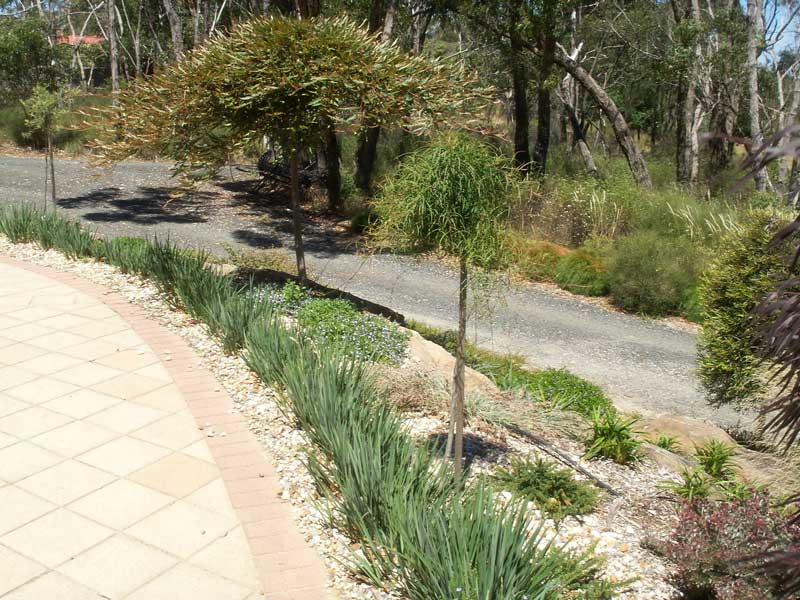
https://www.ozbreed.com.au/plant-ranges/strappy-leaf-plants/little-rev-dianella/
Sweet Mist® Phormium tenax ‘PH0S2’ PBR
Sweet Mist® Phormium is an ultra-compact, bronze-coloured Phormium, with exceptional toughness and cleaner foliage compared to varieties like Elfin and Bronze Baby. It offers striking colour contrast, making it ideal for modern gardens.
Size
Sweet Mist® Phormium typically grows to a height of 40 cm and spreads 40 cm wide. For optimal coverage, plant at a density of 6-10 plants per square metre or 3-5 plants per linear metre.
Sunlight Requirements
This plant thrives in full sun to partly shaded positions. In Sydney, it requires a shaded position and irrigation, except in coastal areas where it can handle full sun.
Soil Preferences
Sweet Mist® Phormium tolerates a wide variety of soil types but prefers free-draining soil. It is adaptable and resilient, handling frost and moderate dry conditions well.
Care
Care for Sweet Mist® Phormium includes watering as required for the first 8-13 weeks until established, with additional watering needed in summer. Plant it in a well-mulched garden, using chunky mulch, and ensure the crown or base of the plant is not below soil level. Apply slow-release fertiliser in spring if necessary. Remove older foliage at the base as needed or cut back to half the height every 5-7 years for maintenance, though it looks better with pruning every 5 years.
Climate
Suitable for:
- Victoria
- Tasmania
- South Australia
- Western Australia
- Australian Capital Territory
- New South Wales (not suited to north of Sydney and Queensland)
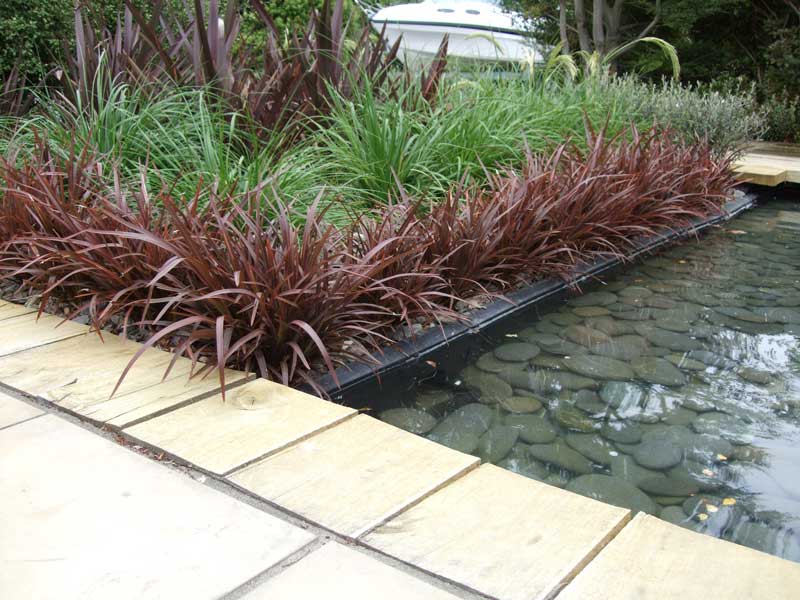
https://www.ozbreed.com.au/plant-ranges/strappy-leaf-plants/sweet-mist-phormium/
Bingo Blue™ Agapanthus hybrid ‘ANDbin’ PBR
Bingo Blue™ Agapanthus is a compact plant that produces bright blue flowers for an extended period. These flowers are predominant from October to November and can also appear sporadically throughout the year. The plant boasts good disease resistance and demonstrates toughness, being both drought and frost tolerant. It’s a small variety that can fit into smaller spaces much better than other varieties.
Size
Bingo Blue™ Agapanthus typically grows to a height of 40 cm and spreads 60 cm wide. The flowers can reach a height of 60-80 cm. For optimal coverage, plant at a density of 4-6 plants per square metre or 2-4 plants per linear metre.
Sunlight Requirements
This plant thrives in full sun to part shade positions.
Soil Preferences
Bingo Blue™ Agapanthus is suited to most soil types but thrives best in rich, loamy soil.
Care
Care for Bingo Blue™ Agapanthus includes watering as required for the first 8-13 weeks until established. Plant it in a well-mulched garden, using chunky mulch. Apply slow-release fertiliser in spring if necessary to ensure the best flower production. Remove older leaves and spent flower stems as needed to maintain its appearance.
Climate
Suitable for:
- South Queensland
- New South Wales
- Australian Capital Territory
- Victoria
- Tasmania
- South Australia
- Western Australia
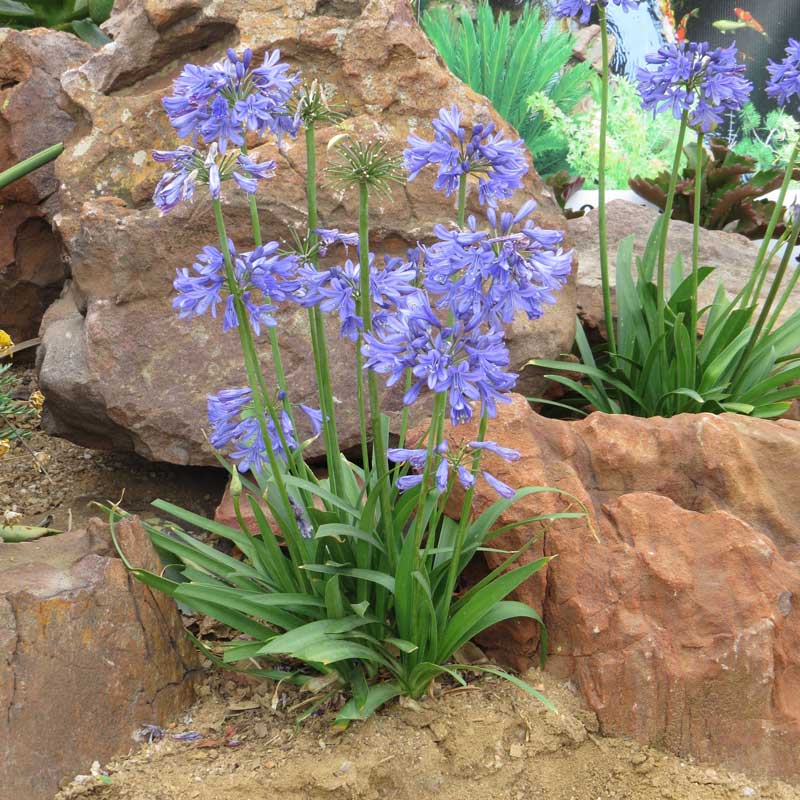
https://www.ozbreed.com.au/plant-ranges/hardy-exotic-range/bingo-blue-agapanthus/
Double Gold™ Gazania hybrid ‘GT20’ PBR
Double Gold™ Gazania is a fast-establishing, spreading ground cover with clean foliage and beautiful yellow flowers that appear for most of the year. It boasts twice the number of flowers compared to other Gazania varieties and is sterile, ensuring it does not produce seeds or cross with nearby Gazanias. Once established, it requires minimal care and is excellent at outcompeting weeds. It’s perfect to grow between pavers in a courtyard garden.
Size
Double Gold™ Gazania typically grows to a height of approximately 20 cm and spreads up to 60 cm wide. For optimal coverage, plant at a density of 3-5 plants per square metre or 2-4 plants per linear metre.
Sunlight Requirements
This plant thrives in full sun, perfect for bright garden spots with reflective heat.
Soil Preferences
Double Gold™ Gazania tolerates a range of soil types from free-draining to heavy clay soils.
Care
Care for Double Gold™ Gazania includes watering as required for the first 8-13 weeks until established. Plant it in a well-mulched garden, using chunky mulch. Apply slow-release fertiliser in spring if necessary. Trim the plant after flowering if required to maintain its appearance.
Climate
Suitable for:
- New South Wales
- Victoria
- Tasmania
- South Australia
- Western Australia
- Queensland (not suited to northern Queensland)

Mighty Coral™ Aloe hybrid ‘AL04’ PBR
Mighty Coral™ Aloe is a semi-compact succulent with multi-stemmed orange and cream flower heads that bloom in early to mid-winter. From a distance, these flowers appear coral pink. This plant is noted for its toughness, including excellent drought and frost tolerance. Its architectural form creates an interesting aesthetic appeal and can fit in smaller gardens.
Size
Mighty Coral™ Aloe typically grows to a height of 35 cm with a spread of 40 cm for its foliage. The flower stems can reach up to 60 cm in height. For optimal coverage, plant at a density of 3-6 plants per square metre or 2-4 plants per linear metre.
Sunlight Requirements
This plant thrives in full sun to part shade positions.
Soil Preferences
Mighty Coral™ Aloe works well with most soil types. However, if planting in clay soils, it is advisable to improve drainage or use a raised garden bed to improve growth conditions.
Care
Care for Mighty Coral™ Aloe involves watering as required for the first 8-13 weeks until established. Plant it in a well-mulched garden, using chunky mulch. Fertilise yearly with slow-release fertiliser. Cut back spent flower stalks to maintain the plant’s appearance if desired.
Climate
Suitable for:
- South Queensland (in raised gardens and well-draining soil)
- New South Wales
- Victoria
- Tasmania
- South Australia
- Western Australia
- Australian Capital Territory (requires further testing)
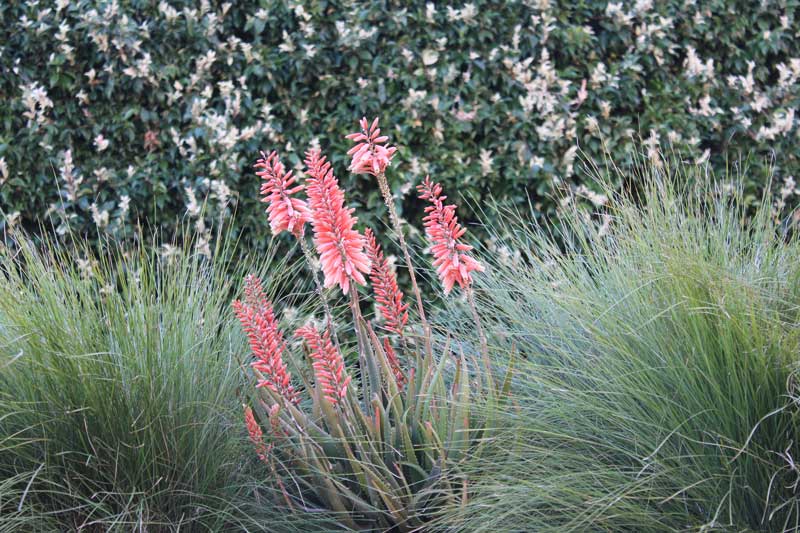
https://www.ozbreed.com.au/plant-ranges/hardy-exotic-range/mighty-coral/
O So Fine™ Gardenia augusta ‘KEN04’ PBR
O So Fine™ Gardenia is a dwarf variety featuring a finer leaf and shorter height, giving it a softer overall appearance. It produces masses of white flowers due to its shorter internodes, making it quite dense and a good ground cover choice, particularly effective at outcompeting weeds.
Size
O So Fine™ Gardenia typically grows to a height of 30 cm and spreads up to 1 metre wide. For optimal coverage, plant at a density of 1-3 plants per square metre or 1.5-3 plants per linear metre.
Sunlight Requirements
This plant thrives in full sun to part shade positions.
Soil Preferences
O So Fine™ Gardenia suits well-drained, moist soils. It is adaptable and can tolerate drought conditions once established.
Care
Care for O So Fine™ Gardenia involves watering as required for the first 8-13 weeks until established, and keeping the soil moist during dry weather. Protect the plant from heavy frost. Plant it in a well-mulched garden using chunky mulch. If required, use slow-release fertiliser in spring. Trim the plant 1-2 times a year to maintain its appearance.
Climate
Suitable for:
- Queensland
- New South Wales
- Australian Capital Territory
- Victoria
- Tasmania
- South Australia
- Western Australia

Flirt™ Nandina domestica ‘MURASAKI’ PBR
Flirt™ Nandina is a low-growing, spreading plant bred from Harbour Dwarf. It features striking red new growth in spring and autumn, with more red appearing in summer. Unlike other nandinas that turn red in winter, Flirt™ Nandina remains green during this season. While some nandinas can be weedy, this variety doesn’t spread from seed.
Size
Flirt™ Nandina typically grows to a height of 30-40 cm and spreads 40-50 cm wide. For optimal coverage, plant at a density of 4-6 plants per square metre or 2-4 plants per linear metre.
Sunlight Requirements
This plant thrives in full sun to moderate shade positions.
Soil Preferences
Flirt™ Nandina can tolerate a range of soil types, from free-draining to heavy clay soils.
Care
Care for Flirt™ Nandina includes watering as required for the first 8-13 weeks until established. Plant it in a well-mulched garden, using chunky mulch. If necessary, apply slow-release fertiliser in spring. Prune every 3-4 years if needed to maintain its appearance.
Climate
Suitable for:
- Queensland
- New South Wales
- Australian Capital Territory
- Victoria
- Tasmania
- Northern Territory
- South Australia
- Western Australia
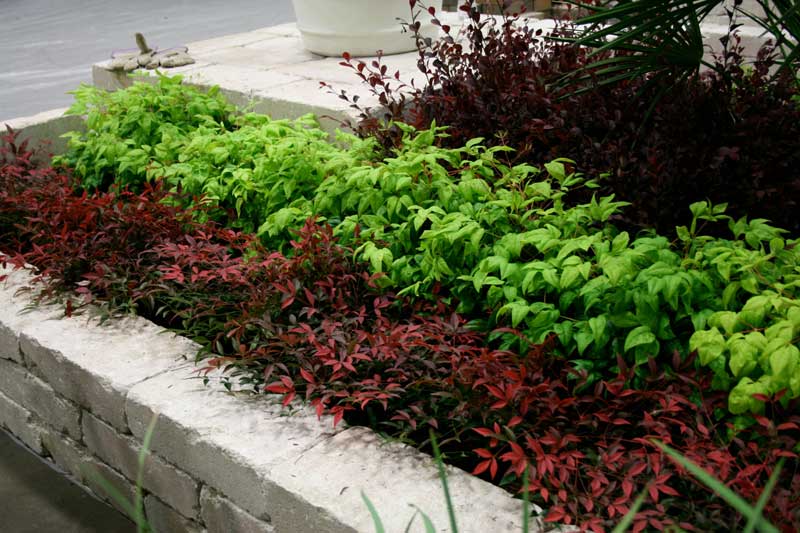
Flirt is the plant with red foliage in the front line of this raised bed. https://www.ozbreed.com.au/plant-ranges/hardy-exotic-range/flirt-nandina/
Purple Pixie™ Loropetalum chinense ‘PEACK’ PBR
Purple Pixie™ Loropetalum is a dwarf, weeping ground cover with rich purple foliage. In spring, it produces showy pink flowers that complement its striking foliage, making it an excellent choice for adding vibrant colour contrasts to small garden beds and containers.
Size
Purple Pixie™ Loropetalum typically grows to a height of 30-50 cm and spreads 1.2-1.5 metres wide. For optimal coverage, plant at a density of 2-3 plants per square metre or 2-3 plants per linear metre.
Sunlight Requirements
This plant thrives in full sun to part shade positions. It is tolerant of frost, humidity, and moderately drought conditions.
Soil Preferences
Purple Pixie™ Loropetalum suits well-drained, moist soils. It thrives best when planted in a well-mulched garden using chunky mulch.
Care
Care for Purple Pixie™ Loropetalum includes watering as required for the first 8-13 weeks until established, and keeping the soil moist during dry weather. Apply slow-release fertiliser in spring to promote healthy growth. Prune every 3-4 years to maintain a height below 30 cm, or more frequently if needed to control its size.
Climate
Suitable for:
- Queensland
- New South Wales
- Australian Capital Territory
- Victoria
- Tasmania
- South Australia
- Western Australia
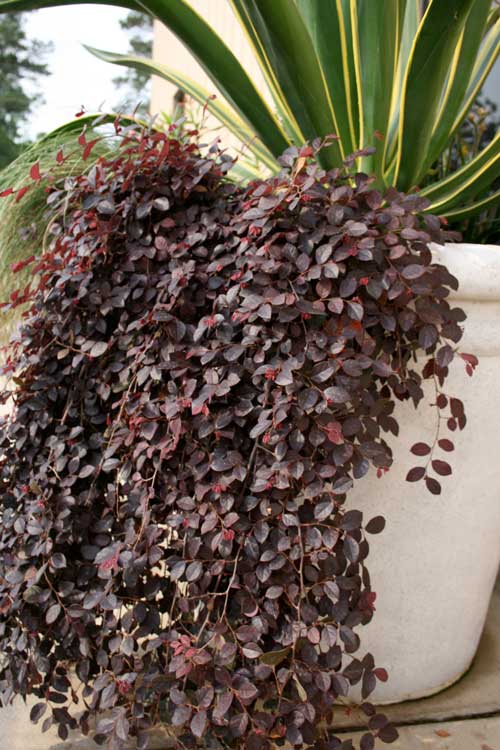
Thin Red™ Photinia x fraseri ‘NP01’ PBR
Thin Red™ Photinia is a narrow hedging plant with a thin growth habit and attractive red new growth foliage. It produces small white flowers in mid to late spring.
Size
Thin Red™ Photinia typically grows to a height of 3-4 metres and a width of 60 cm. For optimal coverage, plant at a density of 1 plant per square metre or 2 plants per linear metre for screening purposes.
Sunlight Requirements
This plant thrives in full sun to part shade positions, making it versatile for various garden settings.
Soil Preferences
Thin Red™ Photinia works with most soil types, showcasing its adaptability. It performs best when planted in well-mulched gardens with chunky mulch recommended.
Care
Care for Thin Red™ Photinia includes watering as required for the first 8-13 weeks until established. Annual fertilisation with slow-release fertiliser is recommended. Prune annually or twice per year for a tidier hedge.
Climate
Suitable for:
- South Queensland
- New South Wales
- Victoria
- Australian Capital Territory
- Tasmania
- South Australia
- Western Australia
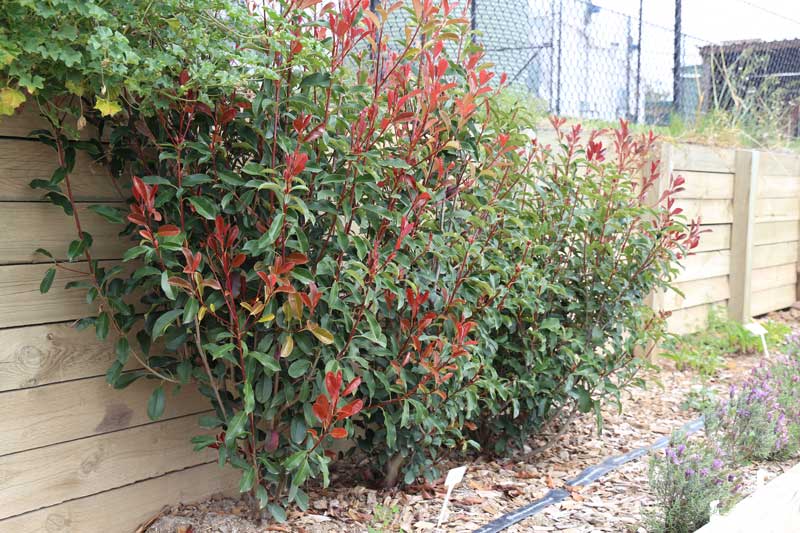
https://www.ozbreed.com.au/plant-ranges/hardy-exotic-range/thin-red/
Rustic™ Poa spp. ‘POL11’ PBR
Rustic™ Poa is a compact, low-maintenance tussock grass with a tidy and clean form. It features lovely green foliage that turns copper more quickly than other Poa varieties which is very much in fashion for modern landscape designs. This plant is perfect for smaller gardens and provides a unique colour contrast to other plants in the garden.
Size
Rustic™ Poa typically grows to a height and width of 45 cm. For optimal coverage, plant at a density of 4-10 plants per square metre or 2-4 plants per linear metre.
Sunlight Requirements
This plant thrives in full sun to part shade positions.
Soil Preferences
Rustic™ Poa can adapt to a wide variety of soils.
Care
Care for Rustic™ Poa includes watering as required for the first 8-13 weeks until established. It benefits from being cut back annually to 15 cm above the ground in autumn or late winter to promote fresh growth and maintain its appearance, but it’s surprisingly resilient given its rush to turn foliage copper.
Climate
Suitable for:
- New South Wales
- Australian Capital Territory
- Victoria
- Tasmania
- South Australia
- Western Australia
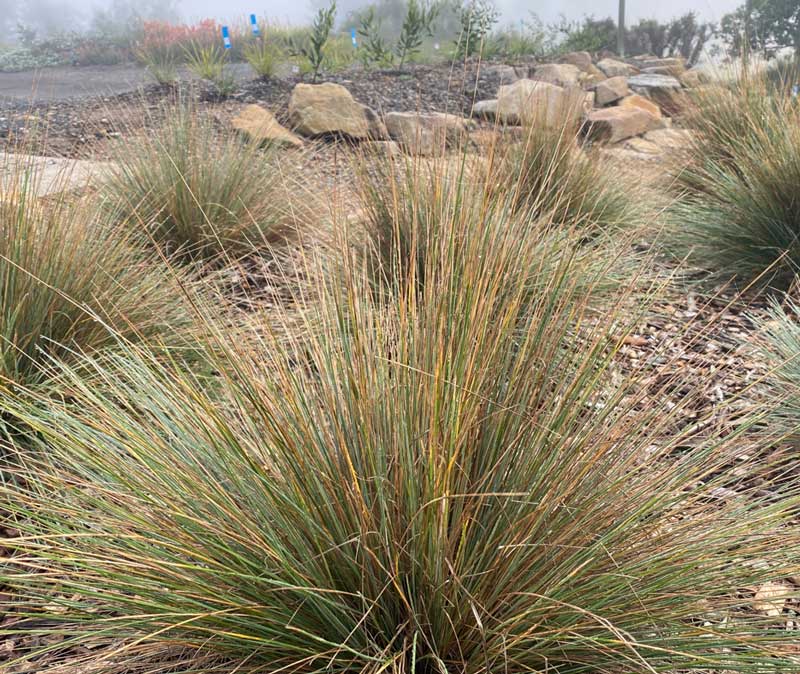
https://www.ozbreed.com.au/plant-ranges/native-grasses/rustic-poa/
Eskdale Blue™ Poa spp.’POL12 PBR
Eskdale Blue™ Poa is a low-maintenance tussock grass featuring lovely arching, deep blue foliage. With an elegant and tidy form, it offers great drought tolerance and can handle very wet conditions. Eskdale Blue™ Poa establishes quickly and outcompetes weeds, decreasing maintenance tasks in the garden.
Size
Eskdale Blue™ Poa typically grows to a height and width of 45 cm. For optimal coverage, plant at a density of 4-10 plants per square metre or 2-4 plants per linear metre.
Sunlight Requirements
This plant thrives in full sun to part shade positions.
Soil Preferences
Eskdale Blue™ Poa adapts well to a wide range of soil types.
Care
Care for Eskdale Blue™ Poa includes watering as required for the first 8-13 weeks until established. It should be cut back annually to 15 cm above the ground in autumn or late winter to encourage fresh, vibrant blue shoots.
Climate
Suitable for:
- New South Wales
- Australian Capital Territory
- Victoria
- Tasmania
- South Australia
- Western Australia
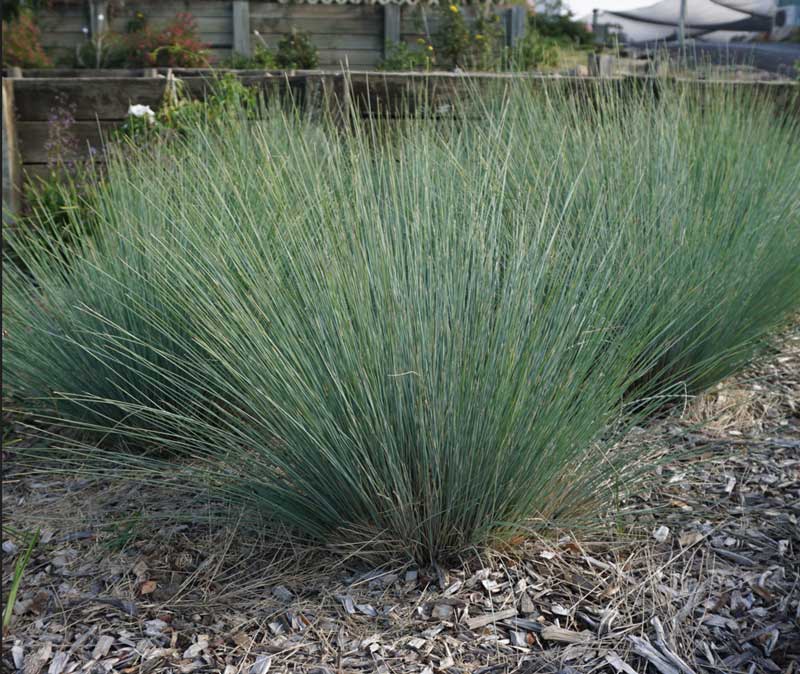
https://www.ozbreed.com.au/plant-ranges/native-grasses/eskdale-blue/
Conclusion
In this article, we’ve explored the key aspects of courtyard gardening, including understanding microclimates, soil and drainage management, sunlight and shade considerations, choosing suitable plants, efficient watering practices, and aesthetic design. We’ve also had a look at a variety of native and exotic plants that are perfect for courtyard gardens.
Apply these insights to transform your courtyard into a lush, vibrant space that maximises its potential. With careful planning and plant selection, even the smallest courtyards can become stunning outdoor retreats.
